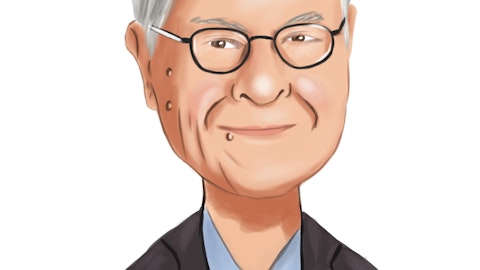Southern Missouri Bancorp, Inc. (NASDAQ:SMBC) Q2 2023 Earnings Call Transcript January 31, 2023
Operator: Ladies and gentlemen, welcome to the Southern Missouri Bancorp Quarterly Earnings Conference Call. My name is Glenn and I will be the moderator for today’s call. I will now hand you over to your host, Lora Daves to begin. Laura, please go ahead.
Lora Daves: Thank you, Glenn. Good morning, everyone. This is Lora Daves, CFO with Southern Missouri Bancorp. Thank you for joining us. The purpose of this call is to review the information and data presented in our quarterly earnings release dated Monday, January 30, 2023 and to take your questions. We may make certain forward-looking statements during today’s call and we refer you to our cautionary statement regarding forward-looking statements contained in the press release. I am joined on the call today by Greg Steffens, our Chairman and CEO and Matt Funke, President and Chief Administrative Officer. Matt will lead off our conversation today with some highlights from our most recent quarter and fiscal year.
Matt Funke: Thanks, Lora and good morning, everyone. This is Matt Funke. Thanks for joining us. We are pleased to report this morning that the December quarter, which is the second quarter of our fiscal year, provided continued growth for Southern Missouri. Shortly after quarter end, we closed our merger with Citizens Bancshares. We will talk more about the merger after reviewing results. Growth this quarter primarily reflected an increase in net loans receivable partially offset by a decrease in other assets. We earned $1.26 diluted per share in the December quarter, that’s up $0.22 from the linked September quarter and down $0.09 from the December 2021 quarter. Net interest margin for the quarter was 3.45% as compared to 3.77% reported for the year ago period and 3.65% reported for the first quarter of fiscal 23, the linked quarter.
Net interest income resulting from accelerated accretion of deferred origination fees on PPP loans was significantly reduced as compared to the year ago period, adding less than 1 basis point during the current quarter as compared to 13 basis points in the year ago period. There wasn’t a material impact in the linked quarter from PPP origination fees either. We viewed our core margin is down about 19 basis points, both quarter-over-quarter and year-over-year. Average interest earning cash and cash equivalent balances decreased compared to the linked quarter and year ago periods as loan growth outpaced deposit growth. Net interest income for the quarter was $28.3 million, an increase of $3.2 million or 12.7% as compared to the same period of the prior fiscal year.
The increase was attributable to a 23.2% increase in the average balance of interest-earning assets partially offset by the decrease noted in net interest margin. On the balance sheet, gross loan balances increased $18 million during the second quarter. Compared to a year ago at December 31, 21, gross balances are up $604 million or 25%. Fortune our Fortune merger in February of 2022 added $201 million over the trailing 12-month period. So net of that, our adjusted annual rate of growth for the year would be a little under 17%. The investment portfolio was down about $4 million over the quarter, while cash and equivalents increased just a little more than $5 million. Deposit balances increased by almost $155 million in the second quarter and increased by $454 million compared to December 31 of the prior year.
The year-over-year increase was attributable in part to the Fortune merger, which provided $218 million in deposits at fair value. We also had more than $28 million we picked up in a branch acquisition no, that’s not accurate, that was actually just before our 12/31 21 period end. FHLB borrowings decreased $163 million compared to the linked quarter end, with the reduction consisting primarily of overnight balances. The company utilized significant brokered CD funding in the current quarter to reduce its overnight position. I will now hand it over to Greg to talk about M&A, credit quality and lending activity.
Greg Steffens: Thanks, Matt and good morning, everyone. I’d like to open by noting that on January 20, we announced the completion of the merger with Citizens Bancshares Company, which is the parent company of Citizens Bank & Trust with 14 branch locations serving customers in the Kansas City metro area, St. Jos, Chillicothe, Maryville, and several other communities in Northern and Central Missouri. Citizens Bank & Trust is now a subsidiary of Southern Missouri with plans to merge into Southern Bank at the time of our data conversion, which is scheduled for late February. Citizens’ locations will complement Southern Bank’s existing footprint, improve our market share in Missouri and provide potential opportunities for enhanced revenue.
Due to their asset-sensitive nature of their balance sheet and their high levels of liquidity, we will hope to mitigate mortgaging compression in our current rising rate environment. As of 12/31, citizens had assets of $973 million, including loans net of $463 million, cash of $224 million, of which $184 million was in overnight Fed Funds, securities of $225 million, many of which are floating rate and deposits of $838 million. Citizens has maintained a great core deposit funding base over its history and will provide an opportunity for us to significantly improve our funding mix. Turning to credit, we did see some uptick in delinquencies, classifications and non-performers this quarter, but continue to feel good about our overall credit profile and borrower performance.
Adversely classified loans were $38 million or 1.25% of total loans at 12/31 compared to $28 million at September 30. Watch and special mention credits totaled a combined $29 million at 12/31, down a bit as compared to $31 million at September 30, reflecting migration from the special mention category to substandard on one 9 million relationship. This one of the hotel loans that we have been monitoring very closely since the pandemic and with the expiration of the payment modification we had allowed. It’s not necessarily a situation where the performance is degraded where we have any new concerns. But the special mention status was intended to be a short-term transitional classification and we ultimately felt it needed to be classified as substandard.
The other hotel loan we have been watching was already classified as substandard. Both of these loan relationships are on P&I payments with amortizations of less than 20 years and our current and continue to exhibit strong guarantor support. Non-performing loans were just under $5 million or 0.16% of gross loans at 12/31, up 3 basis points as compared to September 30 the linked quarter and up 9 basis points from the period 1 year ago. The increase in non-performing loans was attributable to an increase in residential real estate and commercial non-performing loans. Loans past due 30 days or more were up slightly at 30 basis points on average loans, but remain at very manageable levels. There was an increase of 9 basis points from September 30, the linked quarter and almost 16 basis points compared to the very low levels of 1 year ago.
Turning to our ag portfolio, ag production and other loans to farmers were down $27 million in the quarter as we saw expected seasonal pay-downs, but up almost $9 million compared to the same period of last year. Ag real estate balances were up $5 million over the quarter and up $10 million compared to December of last year. Our agricultural customers finished calendar year 2022 in a very strong position and the dry fall weather allowed them to complete the harvest, market grain, close out their books and work through the annual renewals at a faster pace than normal. We expect no issues on renewals with the vast majority of our ag borrowers. Also when we spoke a quarter ago, there was some concern that very low river levels would prevent some of our farmers from marketing their grain in a timely manner.
But at this point, a wet winter has brought river levels back higher and deliveries are more or less caught up to what we consider normal for January. Going into calendar 2023, cotton and corn acreage look set to trend a little bit higher in our loan book. Soybeans will move down a little bit and rise should be steady. Chemical and fertilizer input costs generally follow the cost of oil. And so we saw a downward trend in the second half of the last year, but they have now stabilized and have begun to move a little higher. A number of borrowers have already locked in these costs and with farm commodities generally priced similar to what we saw in the second half of last year, many of our farmers have contracted a reasonable percentage of their expected crop as well taking some price volatility off the table for the new year.
Lora, would you provide some additional details on our financial performance, please?

Photo by Viacheslav Bublyk on Unsplash
Lora Daves: Thank you, Greg. Might hit on some key financial items already, but I wanted to share a few more details on the margin. Matt noted that PPP origination fee recognition has declined to the point that it had no real effect quarter-over-quarter, although a year ago, it was more meaningful. I’d add that this quarter’s 3.45% margin included about 6 basis points of contribution from fair value discount accretion on acquired loan portfolios and premium amortization on assumed deposits, or $493,000 in dollar terms. In the linked September quarter, when we reported a margin of 3.65%, it included a similar benefit from fair value discount accretion of 7 basis points and a year ago when the margin was 3.77%, and we had 13 basis points of PPP origination fee recognition the benefit from discount accretion on acquired loans was 6 basis points.
Compared to the September quarter, we viewed our core asset yield as increasing 27 basis points resulting from higher loan yields and lower average cash and cash equivalents, while our cost of funds was up 49 basis points. Non-interest income was up $171,000 or 3.2% as compared to the year ago period, attributable to increases in other loan fees, bank card interchange income, deposit account service charges, loan servicing fees and other income, which were partially offset by a decrease in gains realized on the sale of residential loans originated for that purpose. The increase in other income was attributable to a gain on the sale of fixed assets of $317,000 as the company sold properties not currently in use that we had picked up in older acquisitions.
This partially offset the fact that the year ago results included gains on our exit from a renewable energy tax credit partnership. While origination of residential real estate loans, for sale on the secondary market was down, we had some offset from gains of sale on and servicing of the guaranteed portion of government guaranteed loans. Compared to the linked quarter, non-interest income was down 1.1%, with the December gain on sale of fixed assets, mostly offsetting a decline in loan-related fees. Non-interest expense was up $2.6 million compared to the year ago quarter, including $608,000 in charges related to M&A this quarter. as compared to $205,000 in the year ago quarter. In addition to the M&A costs, the increase was attributable primarily to health inflation and benefits, occupancy expenses data processing expenses and other non-interest expenses and were partially offset by decreases in foreclosed property expense and advertising.
The increase in compensation and benefits reflected continuing year-over-year increases in compensation levels, increased headcount resulting from the Fortune merger and a trend increase in legacy employee head count. Occupancy expenses increased primarily due to facilities added in the Fortune merger and other equipment of purchases. Compared to the linked quarter, non-interest expense was up a little more than $700,000 and merger-related charges made up much of that increase. The company did see an uptick in net charge-offs during the quarter, but still at a very manageable level with the 300,000 total approximating an annualized 4 basis points on average loan balances. Our trailing 12-month figure is just under $400,000, which rounds to 1 basis point.
The company recorded a provision for credit losses or PCL of $1.1 million in the 3-month period ended December 31 as compared to no provision in the same period for the prior fiscal year. Our allowance or ACL at December 31 was $37.5 million or 1.25% of gross loans and 783% of non-performing loans as compared to an ACL of $37.4 million or 1.26% of gross loans and 960% of non-performing loans at the September 30, 2022, or linked quarter. The required PCL this quarter was driven in large part by an increase in available lines on construction and ag operating loans, requiring a larger allowance for off-balance sheet credit exposures, but it decreased from the $5.1 million PCL in the linked September quarter when a significant increase in outstanding loan balances required us to increase the dollar amount of our ACL.
Our tangible common equity ratio increased 31 basis points during the quarter as capital grew faster than assets due to the slowdown in loan growth, earnings retention and a modest reduction in accumulated other comprehensive law. Matt, do you have other comments?
Matt Funke: Thanks, Lora. Just want to highlight that our loan growth of more than $18 million for the quarter resulted mostly from multi and single-family residential real estate, commercial real estate and a modest contribution from consumer loans partially offset by seasonal pay downs of the ag portion of our commercial loan book. Our West region centered in Springfield, Missouri continues to have loan growth quarter-over-quarter and year-over-year. As expected, our East region, which includes much of our ag activity declined in loan balances this quarter, but it only trails our West region in year-over-year loan growth. We expect organic growth to remain modest in the coming quarter with our pipeline for loans to fund in 90 days at $122 million at December 31, down from $230 million a quarter earlier and down from $158 million reported at this time last year.
Our non-owner CRE concentration was approximately 330% of regulatory capital at December 31, down by 14 percentage points as compared to September 30 and as compared to 288% a year ago. Our volume of loan originations was approximately $281 million in the December quarter, down from $436 million in the September quarter. And in the December quarter a year ago, we originated $335 million. The leading categories this quarter were commercial real estate, single and multifamily residential real estate and construction loans but several of those are also the categories that showed the most slowing this quarter. We mentioned that CD growth was attributable in large part to the use of brokered CDs to fund asset growth, it accounted for $89 million of the $140 million growth in CD balances.
Public unit funds were a little changed over the last quarter, but they are up $100 million from 12 months prior. Deposit growth in the fiscal year-to-date came from our East, West and South regions and it was enhanced by relationships with several new public unit depositors in different communities across our footprint. Our cash balances remain lower as compared to the unusually high balances for much of the last few years, and we ended the quarter in an overnight borrowing position but it was much reduced from September 30 due mostly to our use of brokered funding. On a stand-alone basis, we would have continued to expect competition for deposits to pressure our cost of funds and margin going forward. Although we’d be optimistic but the slowdown in the pace of increases by the Fed would provide some chance for the loan book to begin to catch up.
As Greg mentioned earlier, our merger with Citizens should be a benefit to our liquidity, our management of our cost of funds and it should help to offset some margin pressure as well. Greg, closing thoughts.
Greg Steffens: Yes. Thanks, Matt. In addition to the immediate benefits from combining Citizens balance sheet and ours, we are really looking forward to the long-term opportunities that these markets represent both in the Metro Kansas City and St. Joseph markets as well as the more rural markets as well. We are going to be concentrating on integration and meeting customer expectations in the merger process. And we are really looking forward to the opportunity to grow a good franchise. With that being said, we expect to have plenty on our plate for the time being, and we would expect to not be looking for new M&A opportunities for the near-term. Lora?
Lora Daves: Thank you, Greg. At this time, Glenn, we are ready to take questions from our participants. So, if you would, please remind folks how they make queue for questions at this time.
See also 25 Countries with the Lowest Corporate Tax Rates and 15 Most Undervalued Large-cap Stocks To Buy.
Q&A Session
Follow Southern Missouri Bancorp Inc. (NASDAQ:SMBC)
Follow Southern Missouri Bancorp Inc. (NASDAQ:SMBC)
Operator: We have our first question comes from Andrew Liesch from Piper Sandler. Andrew, your line is now open.
Andrew Liesch: Thanks everyone. Good morning. Question now with the deal done, how we should look at that, look at the construct of the balance sheet, obviously, came in with a lot of cash. Is that going to be used to pay-down some brokered funding right away or allow to put less of an emphasis on deposit growth right now, especially in higher cost accounts? How should we look at that cash balances?
Matt Funke: I think it will be some mix of that with the brokered funding. We did a little bit of a ladder. So, we will have some that rolls off. It won’t be just real significant immediately. We did have some options to call some of our longer term brokered CDs that we issued as well. So, we will want to think about what the rate environment looks like and where that is. Some of it, we would expect to war chest a little bit as liquidity for future loan growth as well.
Andrew Liesch: Got it. And then just looking at the loan-to-deposit ratio now is going to be down towards 90%. Is there a much emphasis on growing deposits out of the legacy franchise at this point?
Matt Funke: We definitely want to continue to grow our non-maturity deposits. I would expect that we would not feel pressured to be quite as aggressive on pricing going forward.
Andrew Liesch: Got it. And then just on the expenses going forward, when do you expect to have all the cost saves in the run rate?
Matt Funke: I think July 1, we should be pretty much all the way there as far as the cost saves. We will have a fair amount of it achieved within the June quarter.
Andrew Liesch: Wonderful. Thank you for taking the questions.
Matt Funke: Thanks Andrew.
Operator: Thanks Andrew. Our next question comes from Kelly Motta from KBW. Kelly, your line is now open.
Kelly Motta: Hi. Thanks so much for the question. Maybe I would start on loan growth and kind of you mentioned a slowdown of some sort. Just wondering on kind of what you are anticipating for loan growth as we look forward. And if there is any categories that you see having better risk-adjusted returns at this point in the cycle, interested in your thoughts on the outlook for growth in demand as well as the categories that are most attractive to you at this point?
Greg Steffens: We do anticipate having modest loan growth during the March quarter. And then historically, we have quite a bit more growth in the June quarter as our ag lines begin really drawing up in earnest again. So, part of the seasonality that we have historically had, we would expect some of that same seasonality for our 2023 calendar year. As far as categories of loan growth, now by and large, we are looking for a lot of our growth to continue patterns that we have had historically. We would anticipate a little bit more in owner-occupied CRE and some C&I than what we have historically had, but we are still going to continue to have growth in our non-owner occupied CRE buckets, and we will continue to have some growth in our residential lending portfolios. Overall, our growth rate for 23, we would expect to be slower than what we had in calendar year 2022. But we do expect growth to continue.


